 |
||
|
||
| ||
 We start our story about one more video card based on the GPU GeForce3 NVIDIA. Today such cards are still too expensive for an ordinary user. But before purchasing this GPU it is necessary to estimate whether your computer will be well balanced. It makes no sense to use this GPU on the machines with a CPU less than 1 GHz. But with time, when GeForce3 based cards will transfer from the High-End category to the mainstream market, the total cost of a computer upgrade with an aim to reach an ideal balanced components (including a GeForce3 card) will be áóäET feasible for the most of users who want modern computers. That is why if today you can't afford it, don't worry - in 3-4 months it will be possible. Components which lower its level always drop in price, just look at the price movement of the GeForce2 cards. Another factor contributing into the price abatement is competition. The more GeForce3 cards on the market from different vendors, the more dynamic a price policy will be conducted by distributors and resellers. In case of mass promotion of similar products it is easier to make money on the turnover lowering the price as much as possible. I have already written that each new review on a video card based on this GPU won't repeat the ideas given before but will help you to look at this GPU from another standstill. In this review, apart from the examination of the card, we will touch operation of the GeForce3 with the S3TC texture compression technology enabled in the Direct3D (3DMark2001). Hong Kong company Innovision Multimedia is an ambiguous phenomenon. On the one hand we are studying only those cards which get onto the Retail-market. It means that they are supported by the vendor who is responsible for their quality (GF2 GTS, Pro,Ultra). On the other hand, the market is filled up with ÎEM-cards from Innovision, whose quality is often very bad (RivaTNT2-clone based cards, GF256). And then everybody blames a reviewer who examined a product and gave it a high mark, thus praising this company. But let's return to the GeForce3. Innovision Multimedia follows the policy the idea of which is to make a High-End product priced as low as possible. The recommended retail price of the Inno3D Tornado GeForce3 is around $350. The release price will be much lower. When these cards appear on the market, they will be strong competitors to the famous ASUS AGP-V8200. Before examining the card in question I must note that the whole theoretical base connected with this GPU is concentrated in the following articles:
CardThe Inno3D Tornado GeForce3 has AGP x2/x4 interface, 64 MBytes DDR SDRAM memory located in 8 chips on the right side of the PCB. 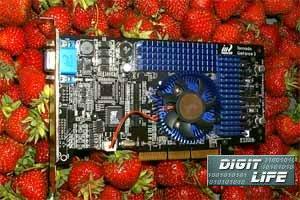 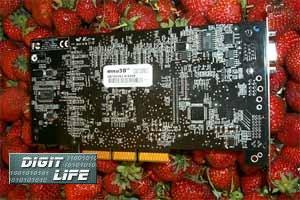 EliteMT produces memory chips with 3.8 ns access time, which corresponds to 260 (520) MHz. The card works at 200/230 (460) MHz like other cards on this GPU. Unfortunately, the chips are covered with heat sinks, and I couldn't learn the marking. But there is no necessity in it since all memory modules are supplied together with the GPU from NVIDIA, that is why it is the same everywhere. The card's design follows the reference one from NVIDIA, which we have already seen on the pre-production samples. 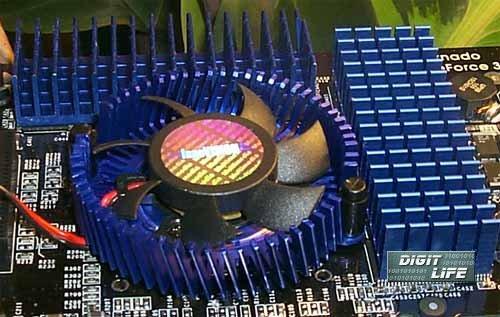 A cooling device installed on the Inno3D Tornado GeForce3 is from ThermalTake, which is famous for its Golden Orb, Chrome Orb, Blue Orb coolers. And the latter cools the processor on this card (on the photo to the right). Heat sinks on the memory modules perform also very well. 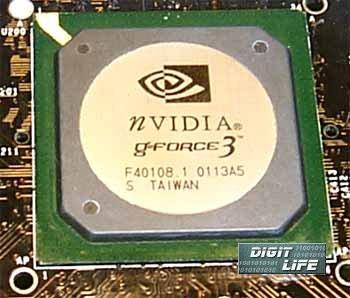 The cooler is attached with the help of clips. Between it and a chip surface there is a thermo-paste layer. According to the marking, the GPU of the A05 stepping was produced on the 13th week of this year. The chip has a metallic lid which is a bit lower than the plastic edges. This sample has neither DVI-interface nor TV-out. The card is black, which is so untypical of Innovision, but at the same time so customary to many users. A combination of the black PCB with a dark-blue heat sink makes the whole design quite stylish with an original holographic sticker in the center of the cooler. 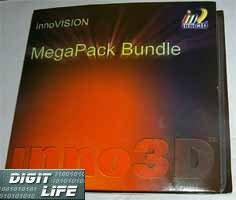  The Retail-package contains the following components:
OverclockingThe Inno3D Tornado GeForce3 could reach 235/272 (544) MHz. Today these results are average among all tested cards on the GeForce3. But an overclocking process depends on a definite sample and cooling conditions. Installation and driversTest system configuration:
For testing we used drivers from NVIDIA of 12.40 version, VSync was off. For comparison the results of the following cards are given:
The card is supplied together with NVIDIA drivers v12.00, settings of which allow for adjusting the majority of necessary functions. But for advanced users I would recommend to enable some more functions with the RivaTuner by Aleksei Nikolaychuk, which I have written about in the ASUS AGP-V8200 Deluxe review. In particular, it helps to enable anisotropic filtering. Test resultsThe Inno3D Tornado GeForce3 has 2D quality not worse than other cards on this GPU do. In 1600X1200 at 75 one can work very comfortably with a large monitor. At 85 Hz you may feel slight discomfort. But it should be noted that the 2D quality depends on a definite sample and on the quality and possibilities of your monitor. For estimation of 3D quality we used the following programs:
Quake3 ArenaThe tests in the demo002 were carried out in two modes: Fast (shows card's work in 16-bit color) and High Quality (shows card's work in 32-bit color), and in the Quaver - at the highest possible quality (detailing levels of geometry and textures are the highest). 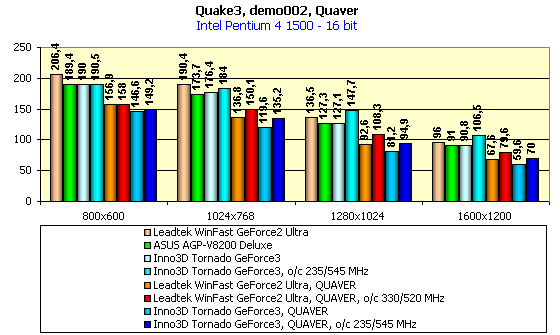  The first four columns show how the card performs in the demo002. We can see that the Inno3D Tornado GeForce3 corresponds to its level and goes almost on a par with its brother ASUS AGP-V8200 Deluxe. It makes no sense to analyze the 16-bit color having such performance results. The GeForce3 cards are accelerators of 32-bit color, and the analyses must be made exactly in the Trucolor. You can see that even the Leadtek WinFast GeForce2 Ultra, being overclocked up to astonishing 330/520 MHz, couldn't catch up with the unoverclocked Inno3D Tornado GeForce3. Therefore, I think that its' useless to speak about the overclocking power of the latter. The Q3DM9 scene in the Quake3 has a big set of large textures, the total volume of which can reach 60 MBytes. Many accelerators have difficulties running this test, especially 32-MB cards, which have some problems with the AGP speed. The complexity of the scene is very high: there are a lot of flashes, smoke effects, a great deal of moving objects. Nevertheless, the GeForce3 easily copes with it even in 1600X1200X32. Of course, it is not the AquaNox with its 170,000 polygons in a scene and not the Giants with its 30,000 polygons, where even the most powerful cards lose. But anyway, the GeForce3 performs very well here. 3DMark2001The tests were carried out in 16- and 32-bit colors with the DXTC texture compression technology enabled.
 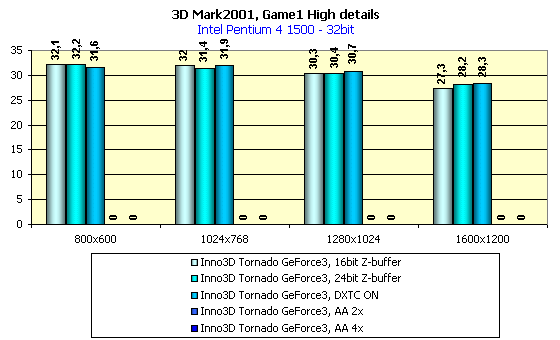 Game1 is a gaming test, an example of a real fighting game-autostimulator of the future with an accurate calculation of physical processes. The scenes are very complex, here are the characteristics: High detail: With the texture compression their volume gets much smaller, but the DXTC doesn't influence the speed, and the memory is sufficient even for the maximum set of textures. 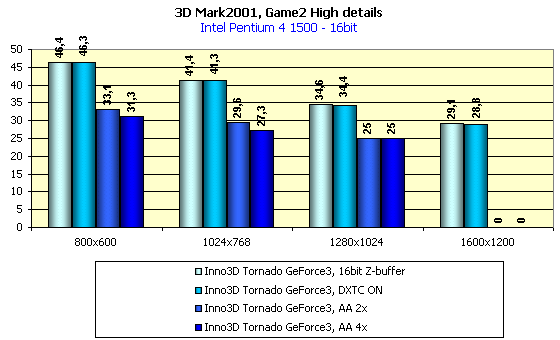  Game2 is a game situation from adventure and role games. The game has a high Overdraw, connected with displaying of a lot of houses which partially cover each other. There are a lot of effects and complex objects. Here are the characteristics: High detail: The texture compression doesn't matter a lot here either. 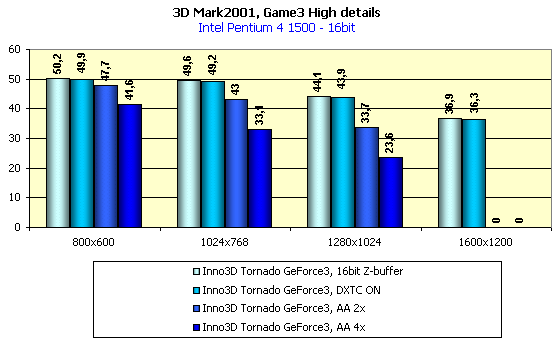 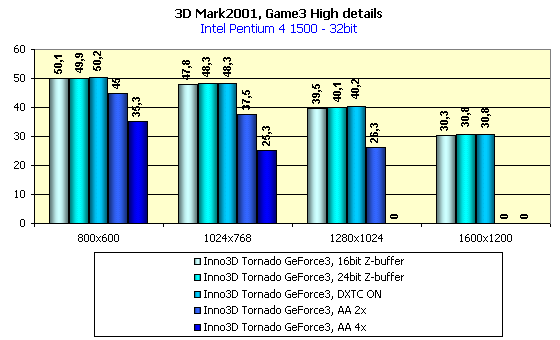 Game3 is an example of a 3D-action. The heroes are based on objects with not many polygons, and the imperfections are quite well seen. But the scene is not simple: there are a lot of reflection effects, dynamic lighting (flashes, glares, shadows). Here are the characteristics: High detail: The texture volume is not very big, and the compression doesn't help it much.  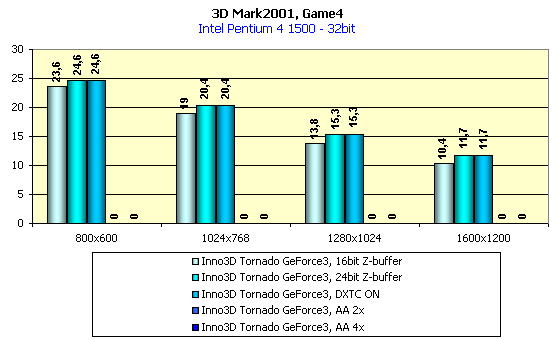 Game4 is a pick of the MadOnion design art. It is difficult to say what genre it is, it is just a beautiful demo. This test uses all possibilities of the GeForce3 as far as shaders are concerned. Besides, there are a lot of complex objects. Here are the characteristics: High detail: You can see that the DXTC does nothing in this test. For more detailed information about the 3DMark2001 tests refer to this review of the GeForce3. I think it's not necessary to comment the results of anti-aliasing activation; the performance drop is usual for this mode. I showed the tests results at different Z-buffer depths. You can see that in 32-bit color the 24-bit Z-buffer makes the speed grow as compared with the 16-bit Z-buffer. I think that the 3DMark2001 has some errors since the performance must be higher in case of the Z16. DVDThe WinDVD player use up all possibilities of the GeForce cards starting from the GeForce256 up to the today's ones. That is why it is very useful for watching DVD-movies with the program MPEG2 decoding. The CPU utilization didn't exceed 23%. ConclusionAlthough Innovision has an ambiguous reputation, its High-End products correspond to the requirements established for video cards of this level. Appearance of such cards on the market will undoubtedly make the prices for GF3 cards drop much more. Of course, $350 is not a very attractive price for the majority, but even now the cards at this price are still difficult to find. I hope the situation will improve by the fall and GeForce3 cards at $300 will be available in a wide range. In our 3Digest you can find a full comparison of characteristics of cards of this and other classes. Highs:
Lows:
Write a comment below. No registration needed!
|
Platform · Video · Multimedia · Mobile · Other || About us & Privacy policy · Twitter · Facebook Copyright © Byrds Research & Publishing, Ltd., 1997–2011. All rights reserved. |